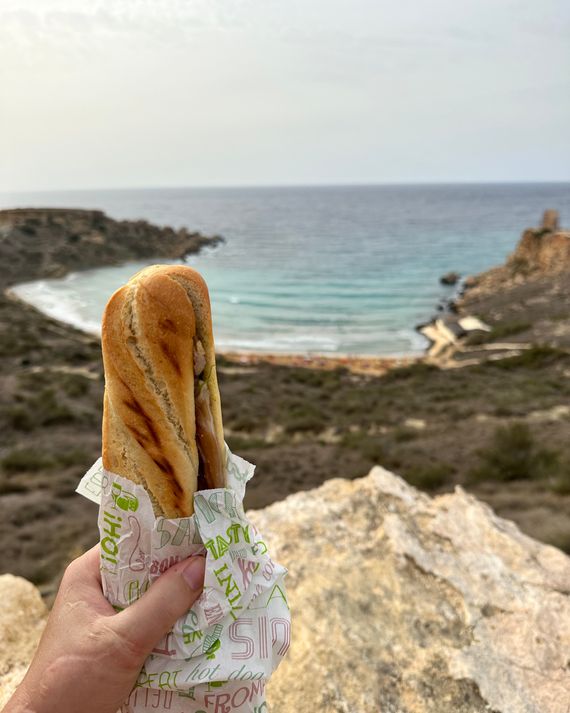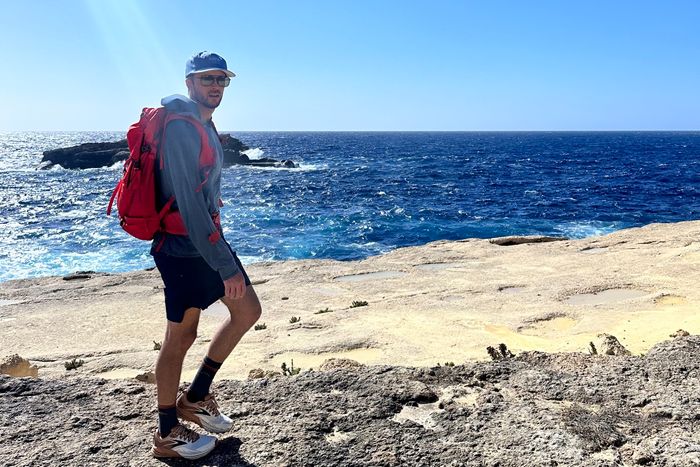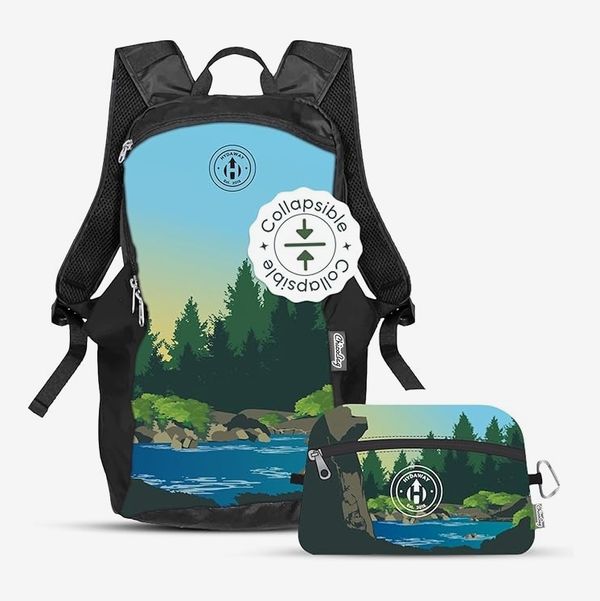
Everyone knows that person who spends weeks sniffing around travel blogs, going deep into Tripadvisor rabbit holes, collecting Google docs from friends of friends, and creating A Beautiful Mind–style spreadsheets to come up with the best vacations and itineraries possible. In this recurring series, we find those people who’ve done all the work for you and have them walk us through a particularly wonderful, especially well-thought-out vacation they took that you can actually steal.
Malta wasn’t on my radar before my partner, Matt, and I started planning a three-week trip to Europe last November. But this temperate Mediterranean island has so much to do and such incredible weather that it made for the perfect five days to kick off our trip. Malta has surfing, hiking, scuba diving, and sightseeing opportunities that include historic churches and filming locations from Game of Thrones, Troy, and Gladiator.
We like to keep our travel planning pretty loose. We outline potential highlights of each destination but rarely book activities in advance or box ourselves into an itinerary. We prioritize free or low-cost activities, which helps me feel more creative in exploration, and allows for a longer trip while staying within budget. Our goal for Malta was to see as much as possible, hike the coastal trails, and explore the region’s history. During our five days there, we ate fresh seafood; toured Valletta, the capital city; and took a high-speed ferry to nearby Gozo for a full day of hiking along massive coastal limestone cliffs.
Lodging, meals, and transit were affordable and logistically simple. The weather was sunny and in the low 70s, and it felt like a place for both city-oriented and adventure-seeking travelers. Here’s how we spent five days in Malta with almost entirely free activities.
Day 1
2 p.m.: Arrive in Malta
We flew two hours from Barcelona to Malta. This was my first experience on Ryanair, a discount European airline that has the tin-can aesthetic of Spirit Airlines but also a cabin crew selling perfume on rolling carts. The tickets were $30 each, though, so no complaints. The Malta airport felt as compact as our home airport in Bozeman, Montana, and since we’d already been through customs the day before, we were outside in the 70-degree sun in just a few minutes. We connected to airport Wi-Fi to figure out transportation to our hotel in Sliema, about ten kilometers north of the airport. It was a straightforward bus ride and cost just two euros each for the 20-minute ride. We chose to stay in Sliema as it sits directly across the harbor from Valletta without the pricier lodging of the capital city, plus it has plenty of restaurants and bus stops.
3 p.m.: Check into Londoner Hotel
We checked into the reasonably priced Londoner Hotel (83 The Strand, Sliema), which recently underwent an extensive interior renovation under new ownership. The 51-room building has harbor views across from a row of open-air restaurants and is just steps away from a walking path along the water. Our room was modern and clean, and the hotel staff was quite patient as I fumbled for my passport after trying to use my U.S. driver’s license to check in. We had booked the Londoner a few weeks before at $95 per night, which was about $30 cheaper than peak season, which is June to August. We try to balance comfort, cost, and location with our lodging. I don’t need anything fancy, but you won’t find me continuing to plummet into my mid-30s in a shared hostel room.
6 p.m.: Order seafood pasta at Trattoria Del Mare
We were still jet-lagged, so after a short nap, shower, and rummaging through my bag for something besides my travel clothes, we went in search of food. We wound up at Trattoria Del Mare (Triq Ix - Xatt Tas-Sliema), a highly rated seafood restaurant just a few blocks from our hotel, with entirely outdoor seating and a full kitchen in a compact building next to the tables. The food was passed through the window, and we could see the whole process from where we sat. I could see the boats in the harbor and the lights of Valletta glittering across the water, and it felt like the perfect start to the trip. I am not a foodie by any means — I would have been perfectly happy filling up on bread dipped in olive oil — but the linguine with fresh seafood in a rich tomato sauce was fantastic. Matt ordered a salmon filet. Both portions were generous, and the meals were just over 20 euros per person. We were early enough to get a table right away, but by the time we finished, there was a fairly long line.
Day 2
10:30 a.m.: Catch the bus to Ghajn Tuffieha
We spent a few minutes during the free hotel breakfast planning the day and settled on hiking and sightseeing near the famous beaches on the northwest side of the island. Malta’s bus schedule is robust, but this particular bus only comes every hour, so it’s worth staying on top of the schedule and making sure you can get where you want to go. The bus is inexpensive (we paid two euros each for the hour ride), but in hindsight, we rode the buses so much it would have been simpler to purchase a five-day pass instead of counting coins for every ride.
1 p.m.: Hike around Ghajn Tuffieha Bay
I used the fast Wi-Fi on the hourlong bus ride to screenshot hiking-route directions, the bus schedule back to Sliema, and load maps for that side of the island. We didn’t get a SIM card or phone plan for Europe, so we were reliant on wireless and planning ahead, which mostly worked.
We considered renting surfboards from Malta Surf School, but then decided to stick to our original hiking plan. We spent an hour reading and relaxing on the beach and watching someone fly their pet parrot around, before heading up a cliffside trail, stopping at a kiosk for five-euro baguette sandwiches with prosciutto and mozzarella. We hiked half a mile up the trail and ate lunch while watching people surfing in the bay below. We ended up spending a few hours hiking the trails over Golden Bay and Gnejna Bay, dropping down to another beach and wheezing our way back up the climb. You can really wind around the trails there, crisscrossing more established routes and getting turned around on livestock paths. There were crumbling huts and larger lookout towers, and our only parameter was making sure we didn’t miss the final bus back to Sliema.
Day 3
9 a.m.: Ride the top deck of the ferry across the harbor
The ferry for Valletta was right across from our hotel and cost less than three euros per person — I recommend buying a round-trip ticket to avoid waiting in the ticket line on the other side. The line was long and we missed the first ferry, but Valletta Ferry Services runs two ferries concurrently, and it was less than 15 minutes before the other boat showed up. We sat on the top deck during the short crossing and watched the walled city get closer. Once you debark the ferry, you walk one of the many steep hills in Malta into the city, then more steep hills on side streets and neighborhoods. Nothing like a good calf burner to get the day started.
11 a.m.: Explore the capital city of Valletta
We toured the Sanctuary Basilica of Our Lady of Mount Carmel, a massive church with vaulted ceilings and incredible sculptural detailing. I was surprised to see it was built in the 1950s, but it was modeled after (and built on the same site as) the original basilica from the 1600s. After it closed for the afternoon, we spent a few minutes in line for St. John Co-Cathedral before seeing it cost 15 euros per person. Instead, we watched exhibition dancers in St. George Square and hauled ourselves up and down the narrow cobbled streets, stopping for espresso and pastries to supplement a light lunch at a counter-service café.


3 p.m.: Mosey around the Upper and Lower Barrakka Gardens
I’m an absolute fiend for gardens, so I was really excited to visit the Upper and Lower Barrakka Gardens (292 Triq Sant’ Orsla). Created in 1661 and opened to the public in the early 1800s, the gardens have multiple levels and overlook the Grand Harbor. The Garden Terrace had a jaw-dropping view of Malta’s fortress walls, including one section that served as an exterior set in Game of Thrones. Rows of olive trees surround fountains, column-supported archways frame the turquoise water, and all of the levels were free to access. We walked down the hill to Herbert Grenada garden, which was quiet and peaceful with stately olive trees and rows of bright flowers. There were plenty of people walking around, but it didn’t feel crowded or chaotic.
Day 4
6:30 a.m: Wake up early to catch the ferry to Gozo
This hike was the only must-do thing on our list, but the timing was tricky as we needed to coordinate two ferries to reach Gozo, one of the more popular islands in the Maltese archipelago. We reserved round-trip tickets for the Gozo Highspeed ferry online the night before, so we caught the 7:30 a.m. harbor ferry to Valletta across from the hotel to make the Gozo ferry connection. Once we arrived in Valletta, we hustled on foot up the steep, hilly streets and back down to the larger harbor on the other side, where we caught the 9:45 a.m. ferry to Gozo.
The seats were nice inside, but it was a nauseating ride on the fastest ferry I’d ever ridden on. We wobbled off after 45 minutes and located the start of our hike on blurry preloaded maps.
11 a.m.: Hike 14 kilometers along the Gozo cliffs
We started hiking from Mgarr toward Xlendi beach, a 14-kilometer one-way route that climbed toward the high point of the island, then followed dramatic sandstone cliffs plunging 1,000 feet into the sea. The whole route is exposed, and I recommend bringing plenty of water and sunscreen.
The trail was mostly easy to follow, but we had it downloaded just in case. The route took us from cliffside to inland, winding through a small town where we stopped to pet some friendly cats. On a more remote stretch, I saw a paved road that actually dropped down to Ta’ Cenc Il-Kantra Lido Restaurant (Sannat), a white-tablecloth affair perched on cliffs above the sea. They were fully booked for lunch, so I got a slice of cake and a can of Coke and sat on a nearby rock loading up on sugar. We finished by descending spectacular steps built into the cliff down to Xlendi Beach, with the whole route taking about three and a half hours.
3 p.m.: Connect the dots back to Valletta
Our bus screenshots were only of medium relevance, so we had to ask for the best route to get back to the Gozo ferry. We ended up connecting between Victoria and Mgarr, catching the ferry back to Valletta with much calmer water this time. Our legs were smoked from hiking, but we hoofed up and over to the other harbor to catch the ferry back to Sliema.
6 p.m.: Miss the final ferry to Sliema!
The final piece of the bus-Gozo-ferry-Valletta-ferry puzzle was catching the ferry from Valletta back to Sliema. We totally blew it and didn’t check to see what time the ferry finished for the day, which was quite an oversight on a Sunday in the off-season. We had no reception or data to call a taxi, and there were no bus stations near the ferry terminal. We started walking on the side of the road, but had no route loaded for the area, so we kept getting stuck inside the city walls. It was a lovely evening, though, and a few extra miles didn’t bother us. We walked about 3.5 miles around the edge of the harbor until we reached a bus station with a ride to Sliema.
Day 5
10 a.m: Sink-wash clothes and plan the day
We slept in and washed our clothes in the sink at the hotel (Matt and I are both thru-hikers and some habits die hard). We filled up on the hotel breakfast (after enough days eating it, I decided my favorite combo was a crusty roll loaded with butter, cheese, and ham). We used the hotel wireless to plan a day near St. Paul’s Bay to finally get in the water and snorkel.
2 p.m.: Snorkel at Qawra Point Beach
We took a bus to St. Paul’s Bay, then spent an hour walking along a waterside walkway. We passed the Malta Aquarium and street after street of funky little shops and food stands. Malta is famous for its diving and snorkeling, and while we didn’t hit the most popular snorkel spots, St. Paul’s Bay was a convenient destination. We rented two sets of fins and snorkels from Eco Sports (Triq L-Imsell, San Pawl il-Baħar, SPB 2440) for ten euros each. The attendant was super-helpful and pointed out the best snorkeling spots within walking distance on a large wall map.
Qawra Point Beach was a 20-minute walk from the gear shop, and we set up towels and our bags on a small point of warm, flat rock. We alternated between reading books and snorkeling in the calm waters, watching curious fish bump against our feet, vanishing into the underwater vegetation when I moved my arms.
6 p.m. Share one last meal
Our final dinner was at Opa Mediterranean Fusion (163 Triq Ix - Xatt, Tas-Sliema), a Greek restaurant a few blocks from our hotel. We are pretty low-maintenance eaters and had spent most of our other meals at counter-service shops and food kiosks, so it was nice to have a final sit-down meal. We sat outside and got several platters of Greek and Mediterranean food to share before heading back to the hotel to pack for another Ryanair flight the next morning.
Maggie’s Malta Packing List …
This brilliant little backpack is my go-to travel companion on trips where I’ll be hiking, but the trails aren’t the main event. It has a 15-liter capacity, multiple organizational pockets, and adjustable shoulder straps with padding. It also folds into its own pocket and takes up almost no space in my carry-on. On this trip, I used it for day hikes and also as my in-flight personal item.
A cross-body bag is my new nonnegotiable for travel — I’ve had too many close calls stuffing my wallet and phone into pockets. I used this handy little bag for my phone, room key, and wallet, and even tucked a long-sleeve layer into the main compartment during dinner outings without overstuffing it.
These leggings are so soft and stretchy that I would forget I was wearing them, and because they come from a technical clothing company, they feel acceptable to wear multiple days in a row. The light, breathable fabric; high, soft waistband; and classic neutral colors made them indispensable on this trip. Plus, they pack down really small.
This ultracomfortable, wide-leg jumpsuit is my go-to travel item. I love the lightly compressive top, which eliminates the need for a bra, and it tucks at the waist for a flattering fit. The ribbed fabric is stretchy, swishy, and airy but still has enough weight to show the quality of the material. I wore this on its own and paired it with a light sweater depending on the weather, and it always felt comfortable and flattering.
… And Wish List
I brought a bulky, hip-length denim button-down shirt that took up too much space in my bag and didn’t get worn enough. It got the job done when I wanted to look somewhat presentable, but next time, I’ll take the more versatile Carry-On button-down, which packs down smaller, is meant for travel, and feels more comfortable to walk around in.
I used Cotopaxi’s AllPa 42-liter Travel Pack for our four-country tour, which meant long travel days and lugging this pack around for miles. While it’s phenomenal for organizing, it wasn’t a comfortable carry. Next time, I’ll take a backpacking-style travel pack like REI’s Ruckpack. This pack has a similar capacity, and while the AllPa is easier to organize, I would have rather had the backpacking support through the hip belt and shoulder straps, as well as a more balanced carry.
I completely misjudged the weather for this trip and brought Sitka’s Traverse hoodie for a mid-layer. While this zip-up is great for Montana winters, it was total overkill, and I never wore it in Malta. If I had planned better, I would have brought Outdoor Research’s looser, versatile, town-ready fleece. This piece would have been more packable, breathed better, and looked nicer with my dinner and touring outfit.
The Strategist is designed to surface useful, expert recommendations for things to buy across the vast e-commerce landscape. Every product is independently selected by our team of editors, whom you can read about here. We update links when possible, but note that deals can expire and all prices are subject to change.
























